PRINCETON, NJ -- Americans' religious intensity continues to be a major predictor of party identification. A new analysis of more than 29,000 interviews Gallup conducted in November finds that Republicans outnumber Democrats by 12 percentage points among Americans who are classified as highly religious, while Democrats outnumber Republicans by 30 points among those who are not religious.
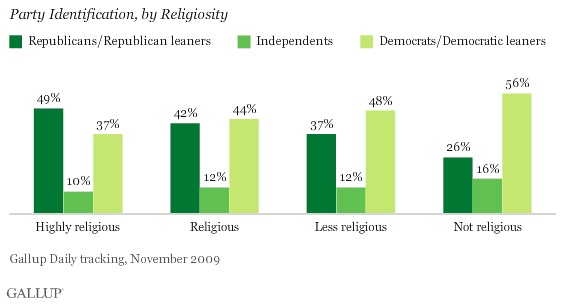
The current analysis is based on 29,192 interviews conducted as part of Gallup Daily tracking during the month of November. Party identifiers include those who initially identify with one of the two major parties plus independents who, in a follow-up question, say they lean toward one party or the other.
Gallup has developed the religious segments based on responses to questions measuring the personal importance of religion and church attendance. Details on the classification process are available at the end of this story.
"As was the case with party identification, whites who are highly religious are more than twice as likely as those who are not religious to disapprove of Obama's job performance, 65% to 32%, respectively."
The basic relationship between religiosity and party identification is quite strong and quite straightforward. The percentage of Americans who identify with or lean toward the Republican Party drops from 49% among the highly religious to 26% among those who are not religious. The percentage who identify with or lean toward the Democratic Party rises from 37% among the highly religious to 56% among those who are not religious. For comparison, the party figures for November among all adults in these data are 40% Republicans/Republican leaners and 45% Democrats/Democratic leaners.
Thus, Republicans are in the plurality among highly religious Americans. For each of the other three groups, Democrats are equal with or higher in number than Republicans. The Democratic edge expands as religiosity decreases. Among the not-religious group, Democrats have a 30-point edge over Republicans.
Differences by Race and Ethnicity
There are significant differences in the relationship between party identification and religion within racial and ethnic groups.
Black Americans are highly Democratic, regardless of their religiosity.
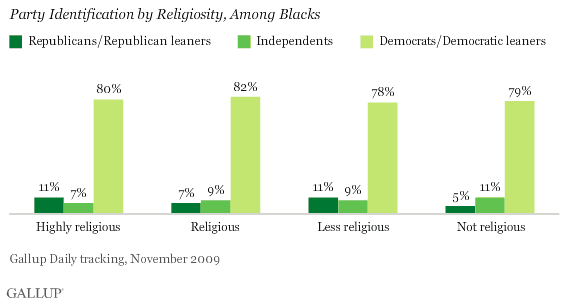
Hispanics also are significantly more likely to identify as Democrats than as Republicans across religious groups, although not as much so as is the case with blacks.
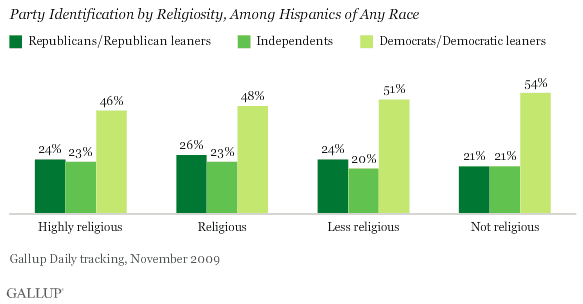
There is a modest tendency for Hispanic identification with the Democratic Party to increase as religiosity decreases. Democratic identification rises from 46% among highly religious Hispanics to 54% among not-religious Hispanics. The percentage of Hispanics who identify as Republicans or who are independents falls slightly as religious intensity decreases. (These data are based on all Americans who identify as Hispanic, regardless of their race.)
The relationship between religiosity and party identification is most pronounced among non-Hispanic white Americans.
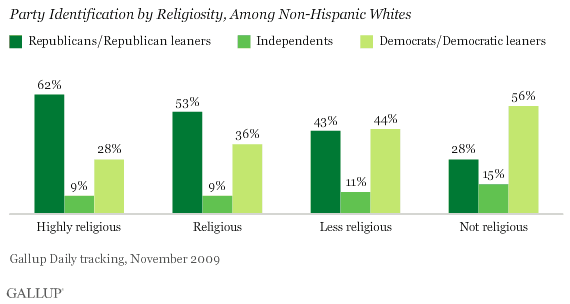
Identification as Republican drops from 62% among highly religious white Americans to 28% among whites who are not religious. On the other hand, white identification with the Democratic Party rises from 28% among the highly religious to 56% among those who are not religious.
Looked at differently, the data make it evident that Republicans are in the clear majority among non-Hispanic white Americans who are either highly religious or religious. Republican and Democratic identification are at rough parity among those classified as less religious. Democrats are clearly in the majority among whites who are not religious.
Although the country in general has become less Democratic over the last 12 months, a comparative analysis shows that almost exactly the same relationship between intensity of religion and party identification among non-Hispanic whites existed last November as exists now.
Obama Approval
Given the strong relationship between party identification and presidential job approval, it is not surprising to find that religious intensity is also highly related to Obama job approval. Previous analysis has shown that Obama has higher disapproval than approval among whites in general.
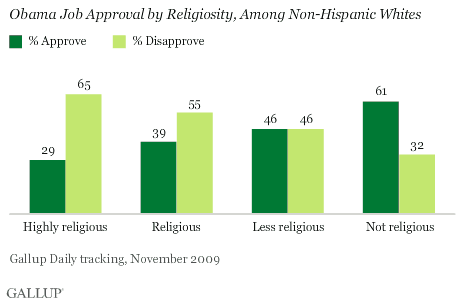
As was the case with party identification, whites who are highly religious are more than twice as likely as those who are not religious to disapprove of Obama's job performance, 65% to 32%, respectively. Those who are not religious are, in contrast, about twice as likely as those who are highly religious to approve of Obama, 61% to 29%.
Implications
The current analysis underscores the degree to which religion and politics continue to be highly intertwined in today's America, a state of affairs that has substantial implications for elections and policy issues.
The religious connection is most apparent among non-Hispanic white Americans. Blacks are strongly Democratic in their orientation, regardless of their religiosity. Hispanics also skew significantly Democratic, and while there is a tendency for less religious Hispanics to be more Democratic in orientation than more religious Hispanics, it does not alter Hispanics' basic skew in the Democratic direction.
The pattern is quite different among whites. Identification with the Republican Party overwhelms identification with the Democratic Party by more than a 2-to-1 margin among highly religious whites, and by a still-substantial margin among those who are religious. Exactly the opposite pattern obtains among whites who are not religious, with a 2-to-1 margin in favor of Democratic versus Republican identification.
About 33% of whites are highly religious, and another 16% are religious. Thus, about half of the white population in the U.S. is both highly religious and significantly oriented toward the Republican Party.
The degree to which religion causes or drives political attitudes and voting behavior among whites is unknown. For some white Americans, religion and political orientation may be accidental bedfellows. These individuals could be Republican for a variety of reasons (e.g., agreement with the GOP's economic policy, or their state of residence) that are not at all directly related to their being highly religious. For other whites, however, there may be a direct relationship. For these individuals, religious convictions form the basis for their political and ideological positions, as would be the case for those highly sensitive to social issues such as abortion and gay marriage. Highly religious people can bring an emotion and certitude and intensity of conviction to the political marketplace that can make them a formidable force well beyond their basic numbers.
Appendix: Religious Classification
The highly religious group (34% of adult Americans) includes those who attend church at least once a week and for whom religion is important in their daily lives. The religious group (18%) attends church almost every week or once a month and say religion is important, or attend church at least once a week or almost every week and say religion is not important. The less religious group (32%) attends church seldom or never but says religion is important or attends once monthly or seldom and says religion is important. The not-religious group (16%) is those who say religion is not important and never attend church.
Survey Methods
Results are based on telephone interviews with 29,192 national adults, aged 18 and older, conducted in November 2009, as part of Gallup Daily tracking. For results based on the total sample of national adults, one can say with 95% confidence that the maximum margin of sampling error is ±1 percentage point.
Interviews are conducted with respondents on land-line telephones and cellular phones.
In addition to sampling error, question wording and practical difficulties in conducting surveys can introduce error or bias into the findings of public opinion polls.
